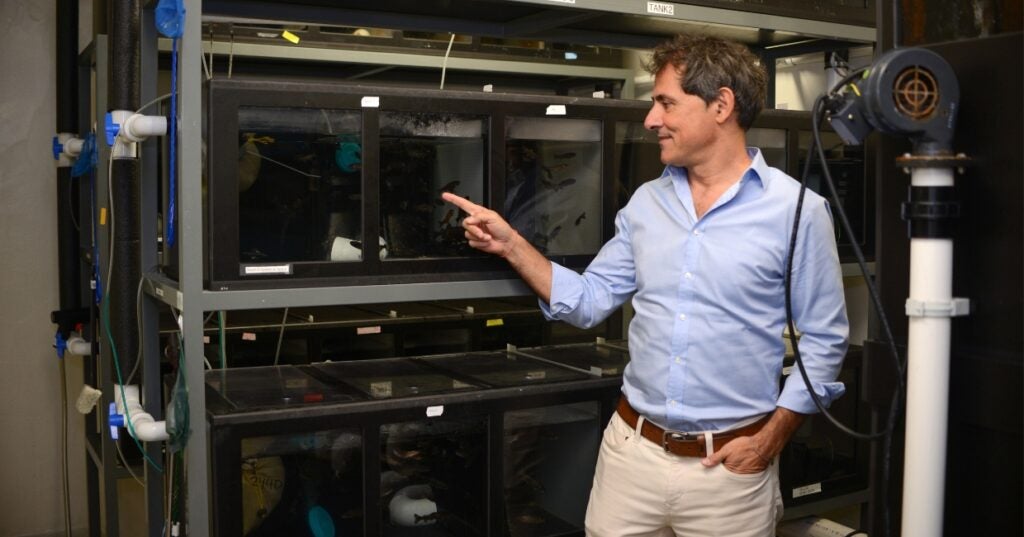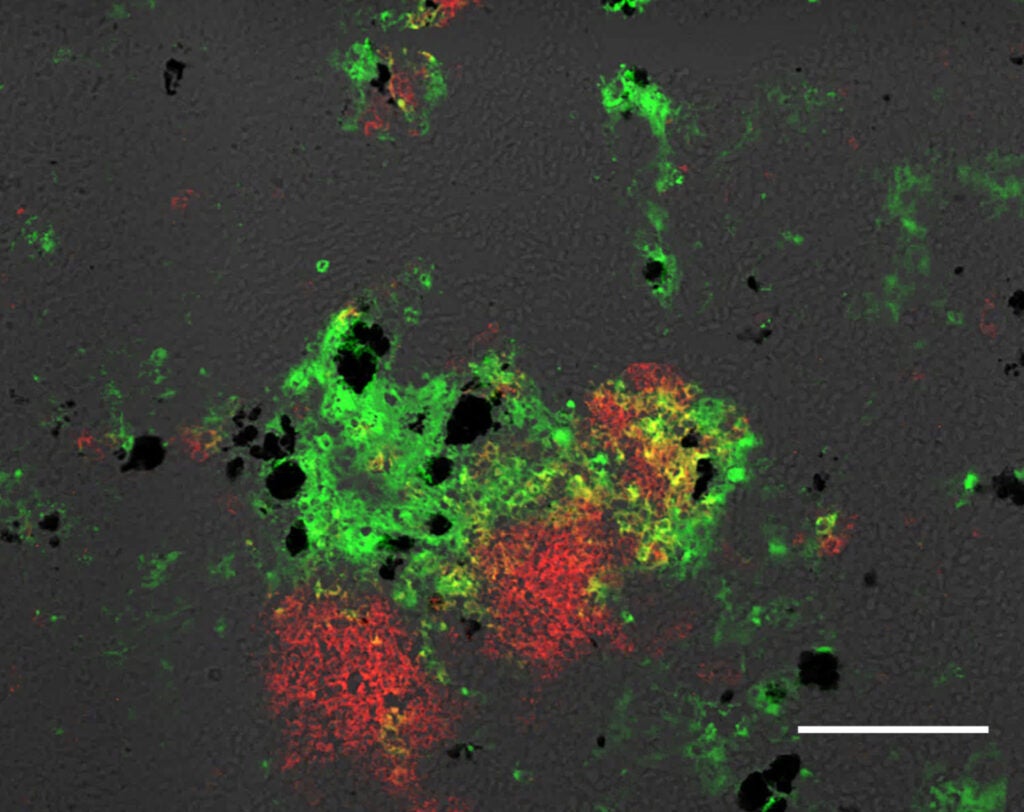Sunyer Laboratory
Research
The Sunyer Laboratory focuses on basic and applied aspects of the fish immune system. Moreover, as teleost fish represent the most ancient living bony species with an immunoglobulin-based adaptive immune system, we use these species to study key aspects of the evolution of adaptive immunity. Our main animal model is Rainbow trout. While earlier work focused on investigating the structure, function and evolution of fish complement (see below refs# 1-7), during the last seven years our studies have mainly focused on B cells and mucosal immunity aspects of teleost fish.
Antibodies Distribution
Currently Available Antibodies
Our laboratory has generated monoclonal and polyclonal antibodies against rainbow trout IgT. After the publication of these antibodies (see ref# 17), we started their free distribution to interested research groups. A full description of these polyclonal and monoclonal anti-IgT antibodies can be found in the datasheets shown below under the ANTIBODY DATASHEETS section. If you are interested in obtaining any of the antibodies displayed in the datasheets, please contact Dr. Sunyer.
Antibodies Under Development:
We have recently produced polyclonal and monoclonal antibodies against rainbow trout IL-10, CD4-1 and CD4-2. We are in the process of characterizing their reactivity and specificity. These antibodies will be freely distributed after they have been fully characterized and after they are reported in a peer-reviewed journal. Peer review publication of a reagent prior to its distribution ensures a high degree of scrutiny by the scientific community which may point to pitfalls of the reagent not previously detected by the laboratory producing it.
CLONE NAME: 41.8
HOST/ISOTYPE: MOUSE/IgG2b
BACKGROUND: Three immunoglobulin classes (IgM, IgD and IgT) are present in teleost fish. IgT, also called IgZ in some fish species, was identified in 2005. In rainbow trout, there are two major B cell subsets expressing either IgT or IgM/IgD, but no B cells expressing both IgM and IgT. In contrast to IgM+ B cells, IgT+ B cells do no co-express IgD. Significant titers of rainbow trout IgT and accumulation ofs IgT+ B cells are detected in mucus and mucosal tissues (skin and gut) respectively from fish infected with mucosal pathogens. Moreover, bacterial microbiota in mucus from gut and skin are prevalently coated by IgT. Therefore, IgT and IgT+ B cells play specialized roles in rainbow trout mucosal immune responses and homeostasis. The above information regarding the production of IgT monoclonal antibodies and the detection of IgT and IgT+ B cells in rainbow trout gut and skin have been reported in the publications shown in the “references” section below.
SPECIFICITY: The clone 41.8 produces mouse IgG2b that recognizes refolded recombinant protein of the constant domains 2-4 of rainbow trout IgT heavy chain which was recombinantly produced in E. coli. This monoclonal antibody recognizes soluble IgT from rainbow trout fluids (plasma, serum, skin mucus, gut mucus) as well as membrane IgT from IgT+ B cells. The antibody specificity was demonstrated in publication #1 of the ”references” section.
IMMUNOGEN: Recombinant protein of heavy chain constant domain (CH2-4 domains) of rainbow trout produced in E. coli.
APPLICATIONS:
- Western blot: 2 μg/ml. Recognizes IgT from serum, plasma, whole cell lysates.
- Perform SDS-PAGE under non-reducing conditions prior to blotting proteins.
- FACS: 2 μg/ml for 100 μL cell (1×107 cells/mL)
PRESENTATION: Protein G purified immunoglobulin in PBS.
STORAGE/HANDLING: Store antibody in aliquot, tightly sealed at +2-4 oC, although sodium azide or Bronidox (both at 0.05%) is recommended as preservative if stored at that temperature for more than 1 day. It is important to avoid multiple thaw and freezing cycles as well as warm and chill cycles. If product requires storage for longer than 1-2 weeks, it is recommended that it is stored at -20-80 oC.
REFERENCES:
- Zhang, Y. A., I. Salinas, J. Li, D. Parra, S. Bjork, Z. Xu, S. E. LaPatra, J. Bartholomew, and J. O. Sunyer. 2010. IgT, a primitive immunoglobulin class specialized in mucosal immunity. Nat. Immunol. 11:827-835.
- Xu, Z., Parra, D., Gomez, D., Salinas, I., Zhang, Y.A., Jørgensen G.L., Skjødt, K., Rasmussen, K.J.,Buchmann K., LaPatra, S.L., J. O. Sunyer. 2013. Teleost skin, an ancient mucosal surface that elicits gut-like immune-responses. PNAS.110:13097-13102.
Important notification: It is possible that during shipment, small volumes of product may become entrapped in the seal of the enclosed vial. Therefore, for products with 250 μl or less, we suggest centrifuging the vial in a tabletop centrifuge in order to dislodge any product in the container’s cap.
HOST/ISOTYPE: Rabbit/IgG
BACKGROUND: Three immunoglobulin classes (IgM, IgD and IgT) are present in teleost fish. IgT, also called IgZ in some fish species, was identified in 2005. In rainbow trout, there are two major B cell subsets expressing either IgT or IgM/IgD, but no B cells expressing both IgM and IgT. In contrast to IgM+ B cells, IgT+ B cells do no co-express IgD. Significant titers of rainbow trout IgT and accumulation ofs IgT+ B cells are detected in mucus and mucosal tissues (skin and gut) respectively from fish infected with mucosal pathogens. Moreover, bacterial microbiota in mucus from gut and skin are prevalently coated by IgT. Therefore, IgT and IgT+ B cells play specialized roles in rainbow trout mucosal immune responses and homeostasis. The above information regarding the production of IgT polyclonal antibodies and the detection of IgT and IgT+ B cells in rainbow trout gut and skin have been reported in the publications shown in the “references” section below.
SPECIFICITY: This polyclonal antibody recognizes the refolded recombinant protein of the constant domains 2-4 of rainbow trout IgT heavy chain which was recombinantly produced in E. coli. This polyclonal antibody recognizes soluble IgT from rainbow trout fluids (plasma, serum, skin mucus, gut mucus) as well as membrane IgT from IgT+ B cells. The antibody specificity was demonstrated in publication #1 of the ”references” section.
IMMUNOGEN: Recombinant protein of heavy chain constant domain (CH2-4 domains) of rainbow trout produced in E. coli.
APPLICATIONS:
- Western blot: 1 μg/ml. Recognizes IgT from serum, plasma, whole cell lysates.
- Perform SDS-PAGE under reducing or non-reducing conditions prior to blotting proteins.
- FACS: 2 μg/ml for 100 μL cell (1×107 cells/mL)
PRESENTATION: Rabbit IgG was first purified by protein G chromatography. Thereafter, specific IgG was affinity purified against a column containing the recombinant immunogen. The antibody is in PBS.
STORAGE/HANDLING: Store antibody in aliquot, tightly sealed at +2-4 oC, although sodium azide or Bronidox (both at 0.05%) is recommended as preservative if stored at that temperature for more than 1 day. It is important to avoid multiple thaw and freezing cycles as well as warm and chill cycles. If product requires storage for longer than 1-2 weeks, it is recommended that it is stored at -20-80 oC.
REFERENCES:
- Zhang, Y. A., I. Salinas, J. Li, D. Parra, S. Bjork, Z. Xu, S. E. LaPatra, J. Bartholomew, and J. O. Sunyer. 2010. IgT, a primitive immunoglobulin class specialized in mucosal immunity. Nat. Immunol. 11:827-835.
- Xu, Z., Parra, D., Gomez, D., Salinas, I., Zhang, Y.A., Jørgensen G.L., Skjødt, K., Rasmussen, K.J.,Buchmann K., LaPatra, S.L., J. O. Sunyer. 2013. Teleost skin, an ancient mucosal surface that elicits gut-like immune-responses. PNAS.110:13097-13102.
Important notification: It is possible that during shipment, small volumes of product may become entrapped in the seal of the enclosed vial. Therefore, for products with 250 μl or less, we suggest centrifuging the vial in a tabletop centrifuge in order to dislodge any product in the container’s cap.
Publications
Cold-blooded vertebrates evolved organized germinal center-like structures Shibasaki Y, Afanasyev S, Fernández-Montero A, Ding Y, Watanabe S, Takizawa F, Lamas J, Fontenla-Iglesias F, Leiro JM, Krasnov A, Boudinot P, Sunyer JO. Sci Immunol. 2023 Dec;8(90):eadf1627. doi: 10.1126/sciimmunol.adf1627. Epub 2023 Dec 1. PMID: 37910630
Evolution of B cell immunity Parra D, Takizawa F, Sunyer JO. Annu Rev Anim Biosci. 2013 Jan;1:65-97. doi: 10.1146/annurev-animal-031412-103651. PMID: 25340015
Biology and mucosal immunity to myxozoans Gómez D, Bartholomew J, Sunyer JO. Dev Comp Immunol. 2014 Apr;43(2):243-56. doi: 10.1016/j.dci.2013.08.014. Epub 2013 Aug 29. PMID: 23994774
Mucosal immunoglobulins of teleost fish: A decade of advances Salinas I, Fernández-Montero Á, Ding Y, Sunyer JO. Dev Comp Immunol. 2021 Aug;121:104079. doi: 10.1016/j.dci.2021.104079. Epub 2021 Mar 27. PMID: 33785432
B cells and their role in the teleost gut Parra D, Korytář T, Takizawa F, Sunyer JO. Dev Comp Immunol. 2016 Nov;64:150-66. doi: 10.1016/j.dci.2016.03.013. Epub 2016 Mar 16. PMID: 26995768

Director, Sunyer Laboratory
J. Oriol Sunyer, PhD
Professor, Immunology, and Pathobiology
Find Us
University of Pennsylvania
School of Veterinary Medicine
413 Rosenthal
3800 Spruce Street
Philadelphia, PA 19104-4539

Behind the Breakthroughs: J. Oriol Sunyer
J. Oriol Sunyer explores how studying the evolution of the immune system reveals surprising connections between fish and human immunity, and what these discoveries could mean for the development of…

A New Study from Penn Vet Reveals an Unsung Immune Defender as a Key Guardian of Gut Health and Metabolism
A pioneering new study published in Nature Microbiology, led by Oriol Sunyer, PhD, and a team of researchers at Penn Vet and the University of New Mexico, have uncovered a…

Scientists at the University of Pennsylvania’s School of Veterinary Medicine Shed New Light on the Evolution of Adaptive Immunity in Cold-Blooded Vertebrates
[December 1, 2023; Philadelphia, PA] – Upon infection or immunization, all jawed vertebrate species generate proteins called antibodies that bind and neutralize pathogens. Strong and long-lasting antibody responses in warm-blooded…
